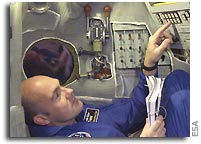André Kuipers’ diary – Part 8: New crew and a memorial service

29 January – 4 February
This week I was once again unexpectedly confronted
with a change to the crew. The last time this happened was a few weeks ago,
when Bill McArthur had to stand down for medical reasons.
The choice of permanent crew for the Space Station is a matter for the
Russians and Americans. I am not involved in the decision. The Russian
cosmonaut Gennadi Padalka has been selected as the Commander, and the NASA
astronaut Mike Fincke as the Second Engineer. These two have already trained
together for a long time for the Space Station. This does not affect my
mission. Padalka is now my new commander in the Soyuz.
Teamwork
We trained together for the first time this week and everything went
perfectly. Padalka has already flown in the Soyuz and he has spent nearly
six months on board the old space station, Mir. We get on well together, and
the teamwork is excellent. It is a pity, of course, that Tokarev and
McArthur will now have to wait for a later flight, but at least they are on
the waiting list.
Apart from the intensive training in the Soyuz, I have to do a lot of
training to get to know the Space Station. In an enormous hall here at Star
City, stand full-size models of the Zvezda and Zarya. These are the Russian
sections of the Space Station, complete with pipe fittings, solar panels and
antennae. They look rather like an overstuffed aeroplane cabin. Inside, you
can see the quarters for the permanent crew, a dining table, exercise
equipment, fans, computers and equipment on every wall because, of course,
there is no ‘up’ or ‘down’ in space. In short, everything that is there for
real has been copied in the simulator.
Leak
In the simulator I can practise doing the scientific experiments and using
all the systems in the Space Station. During the training with the new crew
this week, something started leaking and the air pressure fell. We had to
try to trace the leak and repair it. Eventually, the leak proved to be too
big and we had to evacuate the Station using the Soyuz capsules.
Fortunately, it is just a training exercise now. There is not much chance of
it happening for real, but naturally we are taught to deal with all
eventualities.
On Friday, I went to the Dutch Embassy to celebrate the New Year with the
numerous Dutch people who work in Moscow. It was a pleasant evening. Due to
training in the Soyuz simulator, I was late setting off, and what with the
traffic jams, I only arrived when the evening was supposed to end.
Fortunately, it lasted a lot longer than officially planned!
Memorial service
On Sunday, I attended a rather less festive meeting at the American Embassy.
It was precisely one year since the Columbia Space Shuttle disaster, and
this was commemorated with a solemn ceremony.
It was also a personal commemoration for me. I had been involved in the
medical research and the training of these astronauts, and I showed them
around Amsterdam when they were in the Netherlands. Dave Brown was a good
friend of mine. He even sent me an email from on board the Shuttle. I have
printed his email on a photo of Columbia’s crew, and I will take it with me
on my own journey into space.
Next week I will be in Houston, in America. There I will train on the
American sections of the Station. In the American laboratory I am going to
use a special compartment called the ‘Microgravity Science Glovebox’ to
carry out some of the experiments. This was supplied to NASA by ESA and was
partly built by Dutch companies. I will also learn about many other
procedures, such as how the fire extinguishers, gas masks and alarm systems
work, where I can find all the equipment for my experiments, and how I can
telephone and email to Earth. We will cover all this as a crew, and we will
also run through it with the people who will be keeping an eye on the
mission from the control centre. Something of a dress rehearsal, really.
Emblem
Now that we have a new crew, we also needed a new emblem on our spacesuits.
Our three names are on it, plus a symbolic image. The colours of the flags,
for example, and two groups of stars – one group of four stars and the other
three. Together they represent the number 43, which is the number of years
since Yuri Gagarin went into space. But if you add them up, they also come
to seven – the number of crewmembers on board Columbia.









